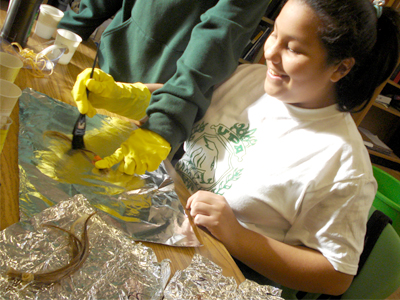
An education in science or engineering is usually a good path to a successful career, though many young students feel the sciences are too challenging for them.
“Some of my friends don’t like science because of the problems you have to solve and they get frustrated,” says Julian Castillo, 12, a middle school student in Oakland. “I love science because you get to do experiments.”
Julian was one of 360 middle and high school students presenting their science research projects at the first annual Alameda County Science and Engineering Fair (ACSEF), which was recently held at Chabot College in Hayward.
The ACSEF provides a forum for stimulating student interest in science, technology, engineering and mathematics (S.T.E.M.). The event is also a competition in which more than fifteen thousand dollars in award money was given in 62 special industry award categories.
ACSEF Director Patti Carothers says that participating in science fairs offers many benefits for students.
“It teaches organizational and presentation skills, and their participation will look very good on a college application,” she says.
Carothers says that it’s difficult to estimate how many students at the event were Hispanic, but says it was probably less than ten percent.
“It would be wonderful to get a much higher Hispanic student involvement,” she says.
Carothers encourages students to get involved in science events. “You have to start somewhere,” she says.
Julian Castillo started at the ACSEF this year with a simple hovercraft he built using a balloon, a plastic plate, and a cereal box. Once his craft was floating on water, his experiment was to test how much load it could support. He placed pennies on the craft until it sank - 254 pennies was its limit.
“It is pretty cool,” he says. “It took me about a week to make the experiment work. It was easier than I thought.”
Yamilet Cardenas, 12, is a sixth-grade student in Oakland. “I want to experiment with the biochemistry of hair coloring products,” she says. “Me and my family wanted to know what happened to hair when we put chemicals in it. I want to become a person who develops things for hair, to make something healthy. I am proud of the work that we did.”
Mario Rodriguez, 17, of Bay Tech School in Oakland worked with two other students to make regular bacteria glow and turn different colors when it comes in contact with lead. Its practical application would be to detect the presence of lead in soil.
“We won second place in an international competition that took place in Texas,” says Rodriguez, who wants to study electrical engineering or another area of engineering.
Emmanuel Sanchez is a teacher at Urban Promise Academy, where 93 percent of students are Hispanic. He says this is the first year that the school’s students competed against other schools at the science fair. Fourteen students from their science class participated.
“The science class is an after school program,” says Sanchez. “Anyone is welcome to attend. We want to engage the kids with math and science, to show them that it is fun.”

